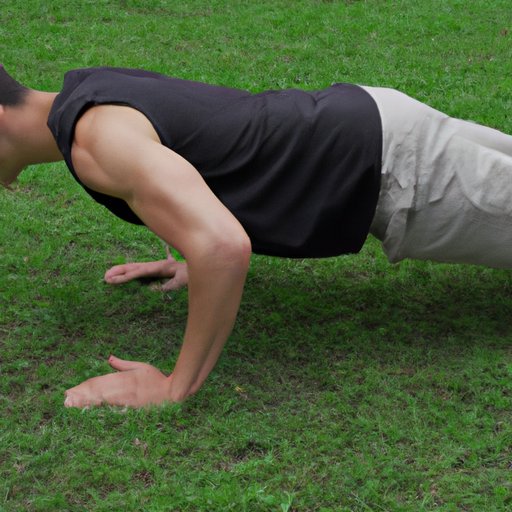
Mastering the Perfect Pushup
When it comes to building upper body strength, few exercises are as effective and versatile as the pushup. Whether you’re a fitness novice or a seasoned athlete, this classic move can be customized to suit any fitness level, target specific muscle groups, and help you build endurance and overall fitness. In this article, we’ll provide a step-by-step guide to performing a perfect pushup, explore different variations you can incorporate into your workout, and offer tips for building endurance and avoiding common mistakes.
A Step-by-Step Guide to Perfect Pushups
Before you dive into advanced pushup variations, it’s important to master the basics. Here’s a step-by-step guide to perfecting your pushup form:
- Get into position: Start in a high plank position with your hands slightly wider than shoulder-width apart and your feet hip-distance apart. Your hands should be parallel to your shoulders and your arms fully extended.
- Engage your core: Draw your belly button toward your spine and engage your glutes and leg muscles, keeping your body in a straight line from head to heels.
- Bend your elbows: Slowly lower your body toward the ground, keeping your elbows close to your sides and your shoulders away from your ears. Your body should remain straight throughout the movement, with your hips and shoulders at the same height.
- Push up: Push through your hands to extend your arms and return to the starting position. Keep your core engaged throughout the movement.
- Repeat: Aim for 10-15 reps, or as many as you can do with good form. As you become more comfortable with the movement, gradually increase the number of reps you do in each set.
When performing pushups, it’s important to maintain proper form to avoid injury and maximize the benefits of the exercise. Here are a few tips for customizing your pushup technique:
- Modifications: if you’re unable to perform a full pushup on your toes, start from your knees and gradually work up to a full pushup over time.
- Hand placement: Experiment with hand placement to target different muscle groups. For example, placing your hands closer together will work your triceps, while placing them farther apart will target your chest muscles.
- Breathing: Inhale as you lower your body toward the ground, exhale as you push up.
Pushup Variations for a Full-Body Workout
To target various muscle groups and avoid plateauing, it’s essential to mix up your workout routine with different pushup variations. Here are a few variations you can incorporate into your workout:
- Wide-grip pushups: place your hands wider than shoulder-width apart to target your chest muscles.
- Diamond pushups: place your hands close together beneath your chest to target your triceps.
- Decline pushups: Place your feet on an elevated surface such as a bench or step to target your upper chest muscles.
- Cobra pushups: Start in a cobra pose with your hands flat on the ground beneath your shoulders. Push up into an upward-facing dog pose,keeping your legs straight. Lower back down to the starting position.
Each variation comes with its own unique set of challenges and benefits. For example, decline push-ups target the upper part of the chest, while diamond push-ups are known to be incredibly effective when it comes to building tricep strength.
How to Increase Your Pushup Endurance
Besides doing more pushups, there are other ways to build endurance and increase the number of reps you can perform in each set over time. Here are a few tips to help:
- Strengthen your core: Your core muscles play a crucial role in maintaining good form during pushups. Incorporate exercises like planks, side planks, and Russian twists to strengthen your core.
- Build upper body strength: work on strengthening your chest, biceps, triceps, and shoulders through exercises like chest presses, bicep curls, and shoulder presses.
- Gradually increase your reps: Set a goal for the number of pushups you want to achieve, then gradually add a few reps to your workout each week until you reach your goal.
Common Pushup Mistakes to Avoid
Pushups may be a simple exercise, but that doesn’t mean they’re easy to perform correctly. Here are a few common mistakes to avoid:
- Sagging hips: lowering your hips lower than your shoulders, which can cause back pain and poor form.
- Flaring elbows: allowing your elbows to flare out to the sides, which places unnecessary strain on your shoulders.
- Not engaging your core: failing to engage your core can lead to poor form and decreased stability during the exercise.
If you’re unsure about your form, consider working with a personal trainer or fitness instructor who can help you perfect your technique and avoid injury.
Pushups for Improved Posture and Mobility
Pushups are a full-body exercise that offer a variety of benefits beyond building upper body strength. For example, incorporating pushups into your workout routine can help improve posture, core stability, and overall mobility. When done correctly, pushups require proper alignment and engagement of the entire body, which can help improve overall physical function and reduce the risk of injury.
Consider incorporating pushups into a larger workout routine that emphasizes functional movement. You’ll not only build upper body strength but also improve your overall fitness and mobility.
Conclusion
Pushups are a simple yet powerful exercise that can be customized to suit any fitness level or goal. From perfecting your form to exploring various variations, building endurance, and reducing the risk of injury, mastering the pushup is an excellent way to build upper body strength and achieve overall fitness. Incorporate these tips and techniques into your workout routine and watch as you gain strength and improve your overall physical function.




